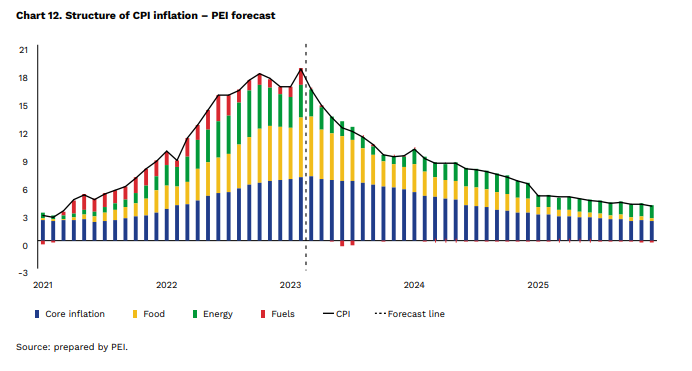The economy has slowed down, but GDP will grow by 2.2% in 2024
Published: 12/04/2023
The Polish economy is at the bottom of the slowdown and inflation has peaked already. We expect inflation to slow down in the coming months and amount to 12.6% in 2023 as a whole. The Polish Economic Institute forecasts that GDP will grow by around 0.8% in 2023 and by 2.2% in 2024. Despite the clear slowdown, the situation on the labour market remains stable. These are the conclusions of the Polish Economic Institute’s “PEI Economic Review: Spring 2023”.
The worst is behind us
We are still witnessing an economic slowdown, but the worst is behind us. Admittedly, GDP growth will slow to 0.8% in 2023, compared to 4.9% in 2022. Q1 will probably be the weakest quarter, with the economy contracting by around 0.5%. However, subsequent months will bring a slight recovery, with growth of 0.5% and 1.0% respectively, mainly due to public spending and corporate investment. The results in 2024 will probably be better than in 2023; we forecast growth of around 2%.
Economic growth will be based on investment to a greater extent. We expect growth in investment growth to decline from 4.5% in 2022 to 2.6% in 2023. However, it will still be more than three times higher than the GDP growth rate. In H1, we expect moderate results — the slowing of mortgage sales will result in poor outlays on the housing market. During this period, bigger changes will be linked to companies’ spending on equipment and transport. In mid-2023, the implementation of pre-financed investments in infrastructure, industry and energy as part of the National Recovery Plan (around 0.6% of GDP) will begin.
We expect a solid inflow of foreign investment. A survey by logistics company Maersk shows that Poland is seen as one of the best countries to transfer production to; for example, from China (so-called nearshoring). Major investments have also been announced by automotive and machinery companies, including production lines linked to electromobility and heat pumps. The record spending on defence will provide an additional stimulus.

Inflation will fall to single digits
Inflation has peaked: in February, it amounted to 18.4%. In the coming months, it will decline in connection with the lower increase in fuel and food prices. The cost of fuel and agricultural raw materials is currently lower than right after Russia invaded Ukraine, which is reflected in retail prices. However, the wide spread of inflation and increase in core inflation remain a problem. We estimate that core inflation reached 12.2% in March and will decrease slightly over the next few months.
Inflation will remain elevated throughout 2023. We expect the CPI to average 12.6% in 2023. At the end of the year, inflation will oscillate around 9%.
Core inflation will play a major role. In 2023, it will average around 11.1% and its deceleration will be gradual. We estimate that products and services that rarely change price are pushing up inflation by around 2.5 pp and its core part by around 4 pp, five times more than in standard conditions. We expect minor changes in the coming months; the slowdown in inflation in this group will be long-term due to the need to update prices with last year’s inflation in subsequent years.
Core inflation will decrease in 2024. We expect the average price increase in this group to be 7%. The slowdown will be linked to the worse global economic situation and the effects of the interest rate hikes, among other things. The lower cost pressure already visible in the PPI indicator will also help. Compared to previous quarters, companies’ inflation expectations have also decreased.

The situation on the labour market is stable
Despite the economic slowdown, the labour market remains stable. Registered unemployment will remain in the 5.5-6% range for most of the year. The number of unemployed people registered in February was lower (by 6%) than in February 2022. We expect an increase in unemployment at the end of the year and the beginning of next year, to around 6.2%.
The number of group layoffs remains low. According to Statistics Poland, 160 workplaces carried out group layoffs in February, 36 fewer than a year ago. They concerned 14,627 people, a 30% decrease compared to last year. However, entrepreneurs’ plans are more pessimistic. In March, representatives of almost every industry said that they would reduce employment over the next 12 months. The most pessimistic answers come from the construction industry and the least pessimistic ones from transport and retail.
In 2023, wage growth will remain in double digits. We expect the average wage to increase by 11.3%. The high inflation will contribute to the decrease in purchasing power in H1; the lower number of new job offers will make it more difficult for employees to negotiate wage increases. We expect the situation to improve in H2, when wages grow 1% faster than inflation.
***
The Polish Economic Institute is a public economic think-tank dating back to 1928. Its research primarily spans macroeconomics, energy and climate, the world economy, economic foresight, the digital economy and behavioural economics. The Institute provides reports, analyses and recommendations for key areas of the economy and social life in Poland, taking into account the international situation.
Media contact:
Ewa Balicka-Sawiak
Press Spokesperson
T: +48 727 427 918
E: ewa.balicka@pie.net.pl
Category: Analysis / Makroekonomia / Press releases / Report / Reports 2023





